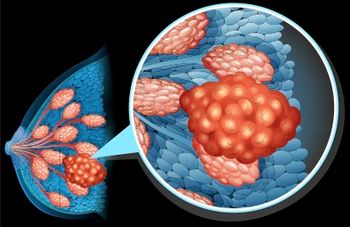
Oncology NEWS International
- Oncology NEWS International Vol 16 No 4
- Volume 16
- Issue 4
Trastuzumab Plus Bevacizumab Promising in Metastatic Ca
The combination of trastuzumab (Herceptin) and bevacizumab (Avastin) as first-line treatment of metastatic breast cancer showed promising results in the first phase II study to evaluate this regimen.
SAN ANTONIOThe combination of trastuzumab (Herceptin) and bevacizumab (Avastin) as first-line treatment of metastatic breast cancer showed promising results in the first phase II study to evaluate this regimen. Mark Pegram, MD, and colleagues from the UCLA School of Medicine reported the findings at the 29th Annual San Antonio Breast Cancer Symposium (abstract 301).
There is strong rationale for this combination, Dr. Pegram said. Overexpression of HER2 is associated with upregulation of vascular endothelial growth factor (VEGF) in breast cancer cells; there is a strong association between HER2 and VEGF, which predicts clinical outcome in primary breast tumors; and in xenograft models, the combination produces superior outcomes, compared with either agent used alone.
The phase II study included 37 patients with HER2-positive metastatic breast cancer and no prior chemotherapy for this stage. All patients received trastuzumab as a 4 mg/kg loading dose, then 2 mg/kg weekly, plus bevacizumab 10 mg/kg on day 7, then every 2 weeks.
Interim efficacy data found an overall response rate of 54.1%, Dr. Pegram reported. Only 16.2% of patients progressed while on the combination (see Table).
Stringent cardiac safety surveillance was part of the amended protocol in 13 patients: Grade 1 cardiac toxicity was noted in seven patients, grade 2 in five patients, and grade 4 in one patient. Mean left ventricular fraction was significantly lower after treatment: 63.42% pretreatment vs 60.24% post-treatment (P = .02), Dr. Pegram said. Other adverse events were mild and manageable, although 15 patients developed hypertension (8 grade 1-2, and 7 grade 3).
"Bevacizumab and trastuzumab is a clinically feasible and active combination in HER2-amplified recurrent or metastatic breast cancer. Our data support the use of therapies directed against both the HER2 and VEGF targets in these patients," Dr. Pegram concluded.
Articles in this issue
over 18 years ago
Curcumin Evaluated for the Treatment of Pancreatic Cancerover 18 years ago
Tykerb Approved for Metastatic HER2+ Breast Cancerover 18 years ago
Drug for BPH May Also Reduce the Risk of Prostate Cancerover 18 years ago
Phase III Trial of Prostvac-VF Is Launchedover 18 years ago
Electronic System Reminds Patients to Schedule Examsover 18 years ago
Phase II Trial of Panzem for Renal Cell Carcinoma Initiatedover 18 years ago
Chemotherapy May Enrich Tumorigenic Cells in Breast Caover 18 years ago
Watchful Waiting Management for Prostate Ca a Hard SellNewsletter
Stay up to date on recent advances in the multidisciplinary approach to cancer.


















































































